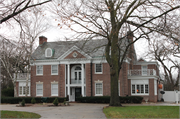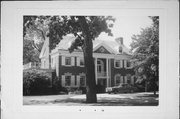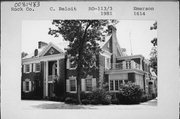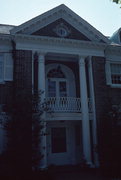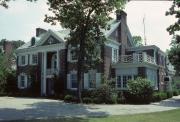| Additional Information: | The red brick Florence Yates house is a Georgian revival structure, rising two stories plus attic with a gable roof. The strictly symmetrical facade is dominated by a two story, pedimented portico which bisects the north elevation and projects outward from the wall. Supported by colossal Corinthian columns and brick pilasters (with quoin-like detailing) the portico shelters a recessed entry and a second story porch. The entry door is surrounded by sidelights and the second story porch features French doors surmounted by a fanlight. The elliptical porch becomes the overhang for the first story entry. The eaves of the house are treated as a classical cornice, with modillion and dentils above an unornamented frieze and architrave. The central pedimented gable, which has a bullseye window, is flanked by two round-headed dormers with interlacing muntins. The multiple-light, double sash windows on the first and second stories are symmetrically arranged and surmounted by flat stone arches with pronounced keystones. The main block-purely rectangular in plan - is bordered by quoin-like brick work and flanked by chimneys which rise slightly above the ridge of the gable. Side wings, recessed back from the main facade, extend on either side of the main block and frame the house like bookends. The rear facade is bisected by a monumental pedimented portico and crowned by round-headed dormers. A garage stands to the rear.
Perhaps the most elaborately detailed and exuberantly executed of Beloit's Georgian Revival houses, the Florence Yates house is an architecturally significant example of the "period revival" architecture which dominated Beloit residential work in the 1920s and 30s. Built in 1927 by a wealthy Beloit family and designed by Rockford architect chester Wolfley, the house combines academically correct detail with a freewheeling spirit and large scale that unmistakably mark it a product of the 1920s, a house that is both lively and stately.
Built in 1927, the home was first owned by Miss Florence Yates. The house was built four years after the death of her father, P.B. Yates, a Beloit industrialist who was founder of P.B. Yates Machine Company (later the Yates-American Machine Company), one of Beloit's larger manufacturing concerns.
In 1883, P.B. Yates established the Berlin Machine Works, which originally manufactured sanding machines, in Berlin, Wisconsin. The plant moved to Beloit in 1887, where it grew from 13 employees and one salesman to 500 employees and 200 different woodworking machines. Mr. Yates revolutionized existing practices with many of his innovative machines, and also built a reputation for marketing machines that were superior in quality to any others on the market. His insistence on quality and durability was responsible for the rapid advance of the Yates-American Company to the forefront of the woodworking machine industry, where it enjoyed a world-wide reputation.
Yates purchased the American Woodworking Machinery Company, with plants in Rochester, New York, and Hamilton, Ontario, in addition to its Beloit plant. Yates-American was one of the earliest manufacturers to have its own foundry and pattern shops; combined with manufacturing and assembly, it was one of the few companies to control production from the time of design to time of sale and use. These machines were involved in virtually every stage of woodworking operations, and it was estimated that most American furniture was fabricated at some stage on a Yates-American machine. They were also installed by the hundreds in schools, where they were used for instructional purposes. They were accepted as the standard for school use just as they were in the industrial field. In the 1930's, the company began to diversify, moving into the radiator field, and building condensers and evaporators for air conditioning and refrigeration industries.
The entire former Yates-American industrial complex of nearly 500,000 square feet on Beloit's west side has been demolished and is largely used for parking by the Beloit Corporation. The former P.B. Yates house on east Broad Street has also been demolished, although the former carriage house remains on 811 St. Paul Avenue. |
|---|

